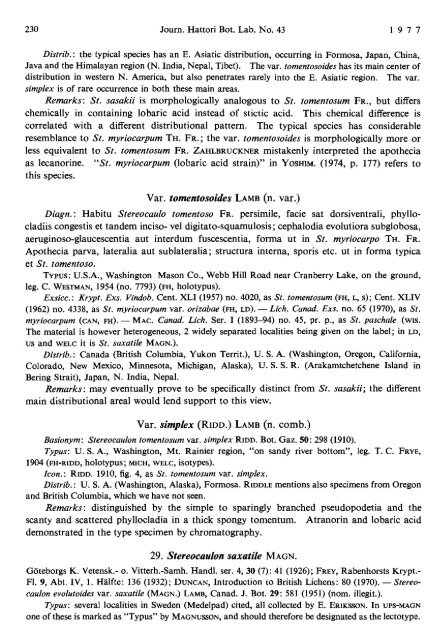A CONSPECTUS OF THE LICHEN GENUS STEREOCAULON ...
A CONSPECTUS OF THE LICHEN GENUS STEREOCAULON ...
A CONSPECTUS OF THE LICHEN GENUS STEREOCAULON ...
Create successful ePaper yourself
Turn your PDF publications into a flip-book with our unique Google optimized e-Paper software.
230 Journ. Hattori Bot. Lab. No. 43 1977<br />
Distrib.: the typical species has an E. Asiatic distribution, occurring in Formosa, Japan, China,<br />
Java and the Himalayan region (N. India, Nepal, Tibet). The var. tomentosoides has its main center of<br />
distribution in western N. America, but also penetrates rarely into the E. Asiatic region. The var.<br />
simplex is of rare occurrence in both these main areas.<br />
Remarks: St. sasakii is morphologically analogous to St. tomentosum FR., but differs<br />
chemically in containing lobaric acid instead of stictic acid. This chemical difference is<br />
correlated with a different distributional pattern. The typical species has considerable<br />
resemblance to St. myriocarpum TH. FR.; the var. tomentosoides is morphologically more or<br />
less equivalent to St. tomentosum FR. ZAHLBRUCKNER mistakenly interpreted the apothecia<br />
as lecanorine. "St. myriocarpum (lobaric acid strain)" in YOSHIM. (1974, p. 177) refers to<br />
this species.<br />
Var. tomentosoides LAMB (n. var.)<br />
Diagn.: Habitu Stereocaulo tomentoso FR. persimile, facie sat dorsiventrali, phyllocladiis<br />
congestis et tandem inciso- vel digitato-squarnulosis; cephalodia evolutiora subglobosa,<br />
aeruginoso-glaucescentia aut interdum fuscescentia, forma ut in St. myriocarpo TH. FR.<br />
Apothecia parva, lateralia aut sublateralia; structura interna, sporis etc. ut in forma typica<br />
et St. tomentoso.<br />
TYPUS: U.S.A., Washington Mason Co., Webb Hill Road near Cranberry Lake, on the ground,<br />
leg. C. WESTMAN, 1954 (no. 7793) (FH, holotypus).<br />
Exsicc.: Krypt. Exs. Vindob. Cent. XLI (1957) no. 4020, as St. tomentosum (FH, L, s); Cent. XLIV<br />
(1962) no. 4338, as St. myriocarpum var. orizabae (FH, w). - Lich. Canad. Exs. no. 65 (1970), as St.<br />
myriocarpum (CAN, FH). - MAC. Canad. Lich. Ser. I (1893-94) no. 45, pr. p., as St. paschale (WIS.<br />
The material is however heterogeneous, 2 widely separated localities being given on the label; in LD,<br />
us and WELC it is St. saxatile MAGN.).<br />
Distrib.: Canada (British Columbia, Yukon Territ.), U. S. A. (Washington, Oregon, California,<br />
Colorado, New Mexico, Minnesota, Michigan, Alaska), U. S. S. R. (Arakamtchetchene Island in<br />
Bering Strait), Japan, N. India, Nepal.<br />
Remarks: may eventually prove to be specifically distinct from St. sasakii; the different<br />
main distributional areal would lend support to this view.<br />
Var. simplex (RIDD.) LAMB (n. comb.)<br />
Basionym: Stereocaulon tomentosum var. simplex RIDD. Bot. Gaz. 50: 298 (1910).<br />
Typus: U. S. A., Washington, Mt. Rainier region, "on sandy river bottom", leg. T. C. FRYE,<br />
1904 (FH-RIDD, holotypus; MICH, WELC, isotypes).<br />
Icon. : RIDD. 1910, fig. 4, as St. tomentosum var. simplex.<br />
Distrib. : U. S. A. (Washington, Alaska), Formosa. RIDDLE mentions also specimens from Oregon<br />
and British Columbia, which we have not seen.<br />
Remarks: distinguished by the simple to sparingly branched pseudopodetia and the<br />
scanty and scattered phyllocladia in a thick spongy tomentum. Atranorin and lobaric acid<br />
demonstrated in the type specimen by chromatography.<br />
29. Stereocaulon saxatile MAGN.<br />
Goteborgs K. Vetensk.- o. Vitterh.-Sarnh. Handl. ser. 4, 30 (7): 41 (1926); FREY, Rabenhorsts Krypt.-<br />
F1. 9, Abt. IV, 1. Halfte: 136 (1932); DUNCAN, Introduction to British Lichens: 80 (1970). - Stereocaulon<br />
evolutoides var. saxatile (MAGN.) LAMB, Canad. J. Bot. 29: 581 (1951) (nom. illegit.).<br />
Typus: several localities in Sweden (Medelpad) cited, all collected by E. ERIKSSON. In UPS-MAGN<br />
one of these is marked as "Typus" by MAGNUSSON, and should therefore be designated as the lectotype.

















